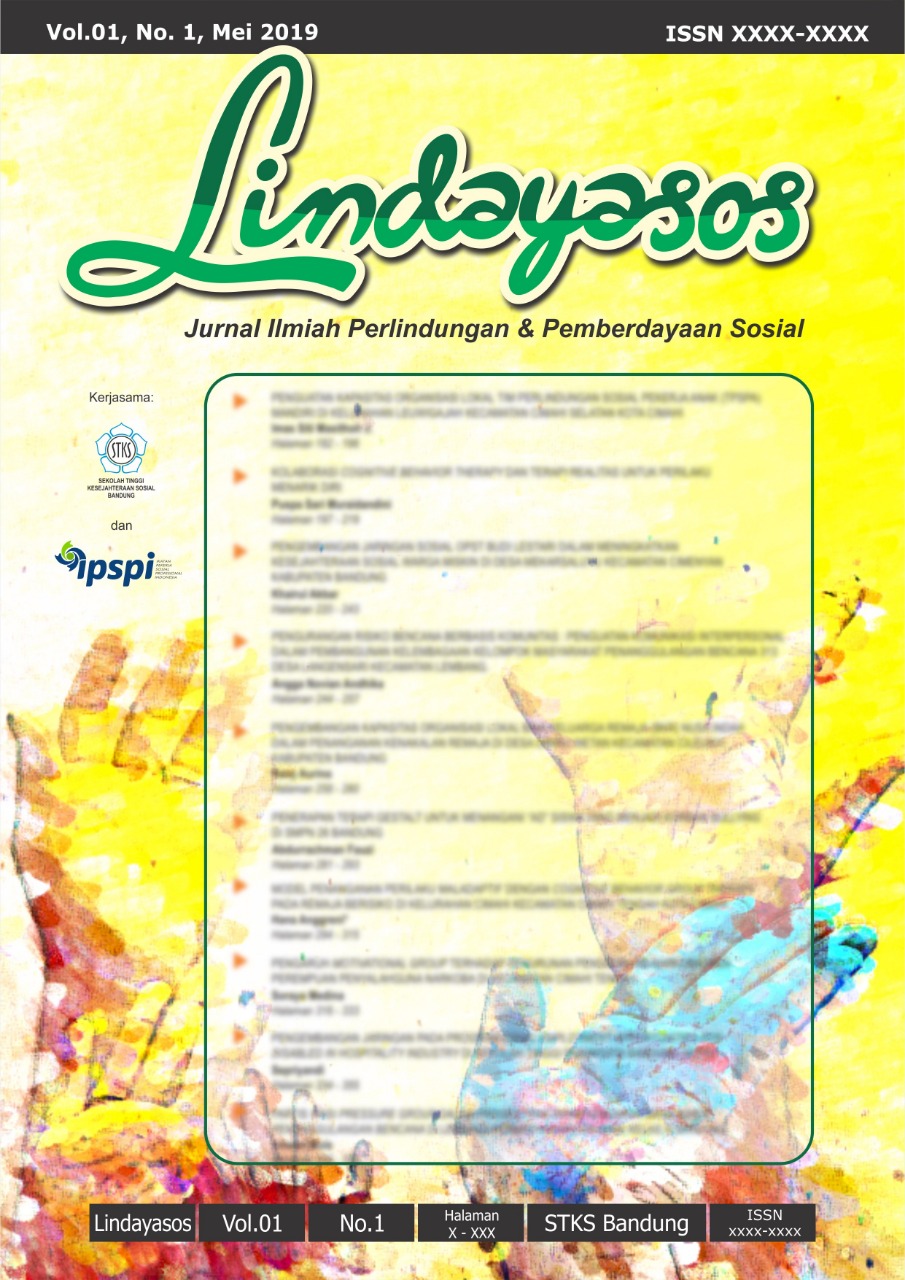Pemanfaatan Modal Sosial Dalam Pemasaran Produk Usaha Mikro di Desa Banjaran, Kabupaten Majalengka
Pemanfaatan Modal Sosial Dalam Pemasaran Produk Usaha Mikro di Desa Banjaran Kabupaten Majalengka.
DOI:
https://doi.org/10.31595/lindayasos.v5i1.774Abstract
In general, micro businesses have weaknesses in marketing including; product, price, place and promotion, so that it is slow in developing its business. Micro enterprises have social capital, namely trust, norms and networks that can be utilized. The purpose of this study was to find out and describe the utilization of micro-enterprise social capital in product marketing in Banjaran Village, Majalengka Regency. The method used in this research is descriptive - qualitative. The data sources used are purposive primary and secondary data sources. Data collection techniques used were in-depth interviews, observation, and documentation studies. The research results show; First, micro business marketing is still simple; unbranded product, no label, very simple packaging. Prices do not take into account similar products from competitors. Location of direct sales at production sites, traditional markets, neighboring stalls/shops. Promotion is done by word of mouth. Second, the social capital that is owned, starting from family, relatives, neighbors and friends of fellow micro-entrepreneurs, grows together with the customs of the people of Banjaran Village. Social capital forms networks, trust, social norms, both among workers and micro-entrepreneurs. Third, the use of social capital in the marketing strategy of micro-enterprises is in the form of good cooperation between them in producing, agreeing on product selling prices, joint sales, providing information and good communication with fellow micro-businesses and consumers. In conclusion, the marketing of micro business products in Banjaran Village, Majalengka Regency is still simple, they have quite good social capital and have been put to good use, the drawback is that they have limited knowledge about marketing.Keywords: Social Capital, Network, Norm, Micro Business, Marketing.
Downloads
References
REFERENCES
Chamdan, Suyatno Purnama. 2010. Motivasi dan Kemampuan Usaha Dalam meningkatkan Keberhasilan Usaha Industri Kecil (Studi Pada Industri Kecil Sepatu di Jawa Timur). Jurnal Manajemen dan Kewirausahaan, pp. 177-184.
Fahrudin, Adi. 2012. Pemberdayaan, Partisipasi dan Penguatan Kapasitas Masyarakat. Bandung: Humaniora.
Friedman, John. 1992. Empowerment: The Politics of Alternative Development. Cambridge, Blackwell.
Frisdiantara, Christea dan Imam Mukhklis. 2016. Ekonomi Pembangunan Sebuah Kajian Teoretis dan Empiris. Malang, Lembaga Penerbitan Universitas Kanjuruhan Malang.
Hikmat, Harry. 2006. Strategi Pemberdayaan Masyarakat (edisi revisi). Bandung. Humaniora Utama Press (HUP).
Hutomo, Mardi Yatmo. Pemberdayaan Masyarakat dalam Bidang Ekonomi: Tinjauan Teoritik dan Implementasi. Oktober 2009. Didapat dari: (www.bappenas.go.id)
Ikhwanuddin, Mohammad Mawardi. 2009.Membangun Daerah yang Berkelanjutan, Berkeadilan, dan Berkelanjutan, Bogor: Penerbit IPB Press.
Kartasasmita, Ginandjar. 1996. Pembangunan untuk Rakyat. Jakarta. Pustaka Cesindo.
Lord, John, dan Peggy Hutchison. 1993. The Process of Empowerment: Implications for Theory and Practice. Canadian Journal of Community Mental Health.12:1 Springer 1993. Didapat dari:(http://www.cjcmh.com/doi/abs/10.7870/cjcmh-1993-0001)
Mardikanto, Totok. 2012. Pemberdayaan Masyarakat dalam Perspektif Kebijakan Publik. Bandung. Alfabeta.
Moleong, Lexy J. 2013. Metodologi Penelitian Kualitatif. Bandung PT Remaja Rosdakarya,.
Noor, Henry Faizal.2007.Ekonomi Manajerial. Jakarta, PT Raja Grafindo Persada.
Nur Firdaus. 2014. Pengentasan Kemiskinan melalui Pendekatan Kewirausahaan Sosial. Jurnal Ekonomi dan Pembangunan LIPI. Vol. 22 No. 1 Tahun 2014.
Primiana, Ina. 2009. Menggerakkan Sektor Riil UKM & industri. Bandung,Alfabeta.
Sugiyono. 2016. Metode Penelitian Kuantitatif, Kualitatif dan R&D. Bandung, Alfabeta.
Suharto, Edi. 2004. Pendekatan Pekerjaan Sosial dalam Pemberdayaan MasyarakatMiskin: Konsep, Indikator dan Strategi. Malang, 12 April 2014.
………..2006. Membangun Masyarakat Memberdayakan Rakyat. Bandung. PT. Refika Pratama.
Soetrisno, Loekman.1995. Memberdayakan Masyarakat di Indonesia dan Kendala
kendalanya. Bestari, Agustus –Desember1995.
Sulistyastuti, Dyah Ratih. 2004. Dinamika Usaha Kecil dan Menengah (UKM) Analisis Konsentrasi Regional UKM di Indonesia 1999-2001. Tesis Master, Universitas Gadjah Mada, 2004.
Tambunan, Tulus. 2002. Perdagangan Internasional dan Neraca Pembayaran: Teori dan Temuan Empiris. Jakarta, LP3ES.
………... 2002. Usaha Kecil dan Menengah di Indonesia Beberapa Isu Penting. Jakarta : PT Salemba Empat.
Anonim. Koperasi dan UMKM jadi Modal Dahsyat (berita online).dari: (http://bappeda.jatimprov.go.id/2013/07/23/koperasi-dan-umkm-jadi-modal-dahsyat/)diakses pada 10 Januari 2022
www.bps.go.id diakses pada tanggal 06 Juli 2022
https://dasril.wordpress.com/e-commerce/ diakses pada tanggal 06 Juli 2022
http://dailysosial.net diakses tanggal 26 Juni 2015.
Kementerian Negara Usaha Kecil dan Menengah Republik Indonesia. 2009.Kliping Digital: UKM Perlu Memanfaatkan TI untuk mengembangkan bisnisnya. http://www.mediacenterkopukm.com/detail-berita.php?bID=3518
M. Suyanto. 2005. Artikel : Aplikasi IT untuk UKM Menghadapi Persaingan Global. Kedaulatan Rakyat. Yogyakarta.
Samuel,Eric,2010.Perkembangane-commerce.http://ericsamuel.blogspot.com/2010/06/ ad-perkembangan-e-commerce.html
Undang-Undang Nomor 20 Tahun 2008 Tentang Usaha Mikro, Kecil dan Menengah
Downloads
Published
How to Cite
Issue
Section
Citation Check
License
Copyright (c) 2023 Ujang Muhyidin Ujang

This work is licensed under a Creative Commons Attribution-NonCommercial-ShareAlike 4.0 International License.
Author(s) who published in this journal agree to following terms:
- Author(s) must understand and agree that the copyright script in published owned by the Jurnal Ilmiah Perlindungan dan Pemberdayaan Sosial. The copyright includes reproducing and selling the manuscript to all parties.
- Everyone can cite every manuscript published in Jurnal Ilmiah Perlindungan dan Pemberdayaan Sosial for educational purposes, with the author's name and the Jurnal Perlindungan dan Pemberdayaan Sosial on reference.








